white house
 I’m not sure why it is that every president “needs” a pet. Nevertheless, it seems that it is expected, and the “first dog” seems to be the most common choice of pet. Dogs are the most commonly talked about pets in the White House…in recent years anyway. The fact is that ever since George Washington, there has been a myriad of different animals that earned the title of presidential pet or first pet. Some of the more manageable animals to come under the care of the president were cats, horses, donkeys, cows, goats, and hamsters. Oddly, there were also the more “unique” animals that lived in the White House too, including, and often only temporarily, bobcats, raccoons, lions, tigers, and bears, if you can believe it.
I’m not sure why it is that every president “needs” a pet. Nevertheless, it seems that it is expected, and the “first dog” seems to be the most common choice of pet. Dogs are the most commonly talked about pets in the White House…in recent years anyway. The fact is that ever since George Washington, there has been a myriad of different animals that earned the title of presidential pet or first pet. Some of the more manageable animals to come under the care of the president were cats, horses, donkeys, cows, goats, and hamsters. Oddly, there were also the more “unique” animals that lived in the White House too, including, and often only temporarily, bobcats, raccoons, lions, tigers, and bears, if you can believe it.
One of the more common kind of animals was the variety of birds that have worn the title pf presidential pet. Birds, such as turkeys, mockingbirds, parakeets, and several other species of parrot and songbird have been the companions of past presidents and their families. One of the presidents that had a bird was Andrew Jackson, the seventh president, who owned a variety of pets, among them, an African grey parrot named Poll that he had purchased for his wife, Rachel. Unfortunately, had very little influence on Poll, because she died of a heart attack not long after his election in 1828. Because of Rachel’s untimely death, and unlike other presidential parrots, Poll took on some of Jackson’s more unbecoming characteristics. To put it mildly, Andrew Jackson was  an exceptionally volatile individual who often disregarded formality. On the one hand, Jackson’s character helped him to actually survive an assassination attempt and to win the Battle of New Orleans. Both of these made him quite popular, even though the treaty that followed the battle, was almost pointless, and so the battle was viewed much the same. On the other hand, as both a general and later president, Jackson used every tool at his disposal to crush indigenous sovereignty. He really had no use for the Native Americans, or at least not for their rights as a sovereign nation. In fact, his actions both directly and indirectly caused the deaths of thousands of Native Americans.
an exceptionally volatile individual who often disregarded formality. On the one hand, Jackson’s character helped him to actually survive an assassination attempt and to win the Battle of New Orleans. Both of these made him quite popular, even though the treaty that followed the battle, was almost pointless, and so the battle was viewed much the same. On the other hand, as both a general and later president, Jackson used every tool at his disposal to crush indigenous sovereignty. He really had no use for the Native Americans, or at least not for their rights as a sovereign nation. In fact, his actions both directly and indirectly caused the deaths of thousands of Native Americans.
Nevertheless, where Poll was concerned, the loss of Rachel and Jacksons crude talk led to a number of problems later on. Poll was therefore almost constantly exposed to the already foul-mouthed and hot-tempered president. I don’t suppose all that matter very much to Jackson, who was obviously used to his own way of speaking, but on the day of Jackson’s funeral, it was decided by Jackson, that Poll was to be in attendance, 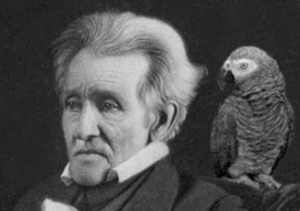 along with the grieving spectators. I can only imagine the guests, especially of that era, Jackson passed away on June 8, 1845, when after possibly being unnerved by the number of people, Poll proceeded to shock all of the guests when he began to exclaim all sorts of profanity and otherwise inappropriate language. According to witnesses, Poll’s outbursts were so disruptive that the bird had to be escorted away from the proceedings. Even after his departure, I’m sure that the prim and proper ladies and gentlemen had to take a moment to compose themselves before the funeral could continue. I guess it just goes to show that sometimes, more than just our children are listening to every word we say.
along with the grieving spectators. I can only imagine the guests, especially of that era, Jackson passed away on June 8, 1845, when after possibly being unnerved by the number of people, Poll proceeded to shock all of the guests when he began to exclaim all sorts of profanity and otherwise inappropriate language. According to witnesses, Poll’s outbursts were so disruptive that the bird had to be escorted away from the proceedings. Even after his departure, I’m sure that the prim and proper ladies and gentlemen had to take a moment to compose themselves before the funeral could continue. I guess it just goes to show that sometimes, more than just our children are listening to every word we say.
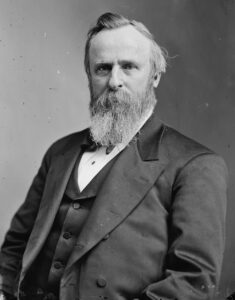 When we think of a president of the United States, we think of one each term. In reality, on inauguration years, there are actually two…the outgoing president, and the incoming president. Of course, if the president has won a second term, there would actually be only one in that inauguration cycle. That is the common fact of presidential inaugurations, but could there be three? The answer is actually, yes. There have been two times in history when there were three presidents in one year. I suppose that potentially there could be more than this, but the reasons would almost be too awful to contemplate.
When we think of a president of the United States, we think of one each term. In reality, on inauguration years, there are actually two…the outgoing president, and the incoming president. Of course, if the president has won a second term, there would actually be only one in that inauguration cycle. That is the common fact of presidential inaugurations, but could there be three? The answer is actually, yes. There have been two times in history when there were three presidents in one year. I suppose that potentially there could be more than this, but the reasons would almost be too awful to contemplate.
On September 20, 1881, Chester Arthur became one of those two “third” presidents, when he was inaugurated that day, becoming the third person to serve as president in that year. The year 1881 began with Republican Rutherford B Hayes in office. Hayes 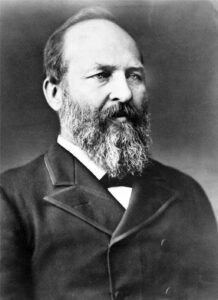 had just completed his first and only term as president, and with the inauguration of James A Garfield, Hayes had officially turned over the reins of government to the new president, who happened to be a close friend of his, in March 1881. Then, the unthinkable happened, when just four months into his term, on July 2, Garfield was shot by an assassin named Charles Guiteau. Guiteau said that he killed Garfield because he refused to grant Guiteau a political appointment. The attack left Garfield with wounds to his back and abdomen. He struggled to recover throughout the summer. Though it appeared he would pull through in early September, Garfield deteriorated by mid-September and finally died on September 19th. An autopsy report revealed that the internal bullet wound contributed to an aneurism that ultimately killed Garfield.
had just completed his first and only term as president, and with the inauguration of James A Garfield, Hayes had officially turned over the reins of government to the new president, who happened to be a close friend of his, in March 1881. Then, the unthinkable happened, when just four months into his term, on July 2, Garfield was shot by an assassin named Charles Guiteau. Guiteau said that he killed Garfield because he refused to grant Guiteau a political appointment. The attack left Garfield with wounds to his back and abdomen. He struggled to recover throughout the summer. Though it appeared he would pull through in early September, Garfield deteriorated by mid-September and finally died on September 19th. An autopsy report revealed that the internal bullet wound contributed to an aneurism that ultimately killed Garfield.
On September 20, 1881…the next day, Vice President Chester Arthur was sworn in as 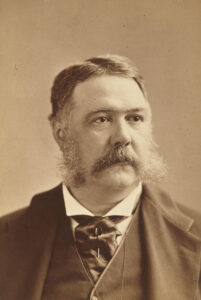 president, making him the third man to be sworn in as president in 1881. Garfield’s assassin then actually had the nerve to write to the new president from jail, and actually taking credit for vaulting Arthur into the White House. While President Arthur was president, not everyone felt like he was a good president. Former President Hayes, said of the Arthur administration, that it was best known for “liquor, snobbery and worse.” Of course, Hayes could have been angry about not being elected to a second term, or he could have been making an honest evaluation. that may be a good subject for a future story. Either way, Chester Arthur served only one term from 1881 to 1885.
president, making him the third man to be sworn in as president in 1881. Garfield’s assassin then actually had the nerve to write to the new president from jail, and actually taking credit for vaulting Arthur into the White House. While President Arthur was president, not everyone felt like he was a good president. Former President Hayes, said of the Arthur administration, that it was best known for “liquor, snobbery and worse.” Of course, Hayes could have been angry about not being elected to a second term, or he could have been making an honest evaluation. that may be a good subject for a future story. Either way, Chester Arthur served only one term from 1881 to 1885.
While this was a very unusual year, it was not the first time this had happened. It was actually the second time in American history that three men served as president in one year. A similar situation occurred in 1841, when Martin Van Buren, William Henry Harrison, and John Tyler all held the office, but that is a different story for another day.
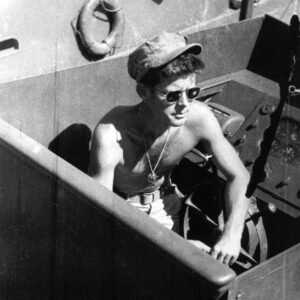
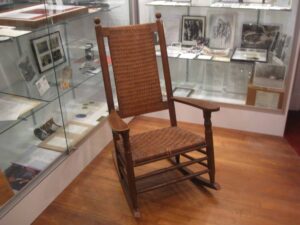 John F Kennedy, who at the time was still our future president, had to “fight” his way into war. His father believed it would make his son more “marketable” for a political run that would eventually land him in the White House. Joseph Kennedy wanted one of his sons to eventually be president, and I’m not sure he was particular about which one it was. He just knew that to have a chance, the “candidate” would have to have a military background. The reasons for his entrance into World War II really don’t matter now, because while he was in the service, he did his country proud, and even saved the lives of his PT-109 crew after a Japanese destroyer rammed them on August 2, 1943.
John F Kennedy, who at the time was still our future president, had to “fight” his way into war. His father believed it would make his son more “marketable” for a political run that would eventually land him in the White House. Joseph Kennedy wanted one of his sons to eventually be president, and I’m not sure he was particular about which one it was. He just knew that to have a chance, the “candidate” would have to have a military background. The reasons for his entrance into World War II really don’t matter now, because while he was in the service, he did his country proud, and even saved the lives of his PT-109 crew after a Japanese destroyer rammed them on August 2, 1943.
Future President Kennedy could have avoided the war completely, because he had back issues which were likely caused from a football injury. In addition, the fact that he was from a wealthy family could have been a big help in any effort he might have used to stay out of the war. He didn’t use the family’s money or influence to stay out, however. Before entering World War II, Kennedy graduated with honors from Harvard, and then still chose to serve. After being drafted to by the Navy, the physical toll on his back increased, including the physically demanding couple of days when the ship he commanded sank and he literally helped his crew survive.
Later, while he was serving as a young senator, Kennedy’s doctor prescribed a rocking chair to be used during his service in the senate. No matter where the pain initially started or what exacerbated the issue, by the time 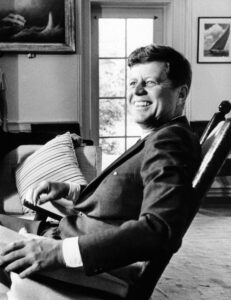
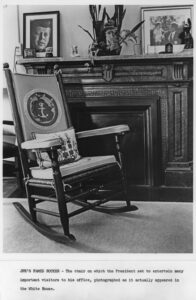 John F Kennedy was in the office of president, he was in constant pain. When he began using the rocking chair in 1955, Kennedy finally found a way for his muscles to relax by constantly being forced to expand and contract while sitting. The rocking chair he chose was made by P and P Chair Company, and Kennedy grew to love it. He finally found some relief, and he actually insisted that the chair be brought aboard Air Force One when he traveled. Later he just purchased many different chairs for his various residences. So impressed was Kennedy with this chair, that he also gifted dozens of the same chair to friends and colleagues. You might say that the rocking chairs from P and P Chair Company were unofficially known as the presidential rocking chairs.
John F Kennedy was in the office of president, he was in constant pain. When he began using the rocking chair in 1955, Kennedy finally found a way for his muscles to relax by constantly being forced to expand and contract while sitting. The rocking chair he chose was made by P and P Chair Company, and Kennedy grew to love it. He finally found some relief, and he actually insisted that the chair be brought aboard Air Force One when he traveled. Later he just purchased many different chairs for his various residences. So impressed was Kennedy with this chair, that he also gifted dozens of the same chair to friends and colleagues. You might say that the rocking chairs from P and P Chair Company were unofficially known as the presidential rocking chairs.
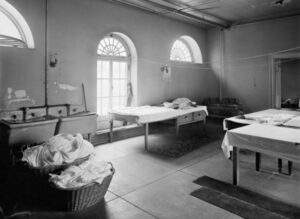
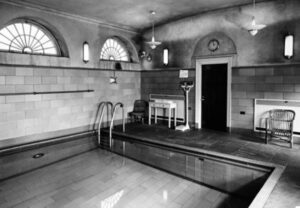 Construction began on the White House on October 13, 1792, and was finally finished on November 1, 1800. Construction was slower in those days, because they didn’t have the equipment we have today. The current White House has 132 rooms. The original White House had 100 rooms. The White House has 54,900 square feet. The White House sits on 18 acres of land. It all it is an impressive building, but there is more to it than just that.
Construction began on the White House on October 13, 1792, and was finally finished on November 1, 1800. Construction was slower in those days, because they didn’t have the equipment we have today. The current White House has 132 rooms. The original White House had 100 rooms. The White House has 54,900 square feet. The White House sits on 18 acres of land. It all it is an impressive building, but there is more to it than just that.
There have been a number of rooms that began as one thing, only to become something else later on. One of the rooms that has had a couple of identities is the Press Briefing Room. These days it is the James S. Brady Press Briefing Room. It was so named after White House Press Secretary James Brady, who was shot and permanently disabled during the assassination attempt on President Reagan. That room, located in the West Wing of the White House was not always such a necessary room, mostly because press briefings are really more of a modern-day thing. The room has always existed, however. In 1909, it was the White House laundry, and during President Truman’s time in office (April 12, 1945 – January 20,1953) it was the White House pool.
By 1950, the White House was 150 years old and in a serious state of disrepair. In order to make is inhabitable 
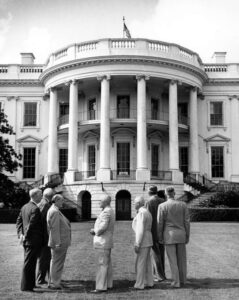 again, the entire building was gutted and rebuilt to make it more stable. It also seemed like a good time to improve on its design, so some improvements and additions were made. White House architect Lorenzo Simmons Winslow designed and built an air raid shelter under the East Terrace on the orders of naval aide Rear Admiral Robert Dennison. There had been a bomb shelter before, but it was built in 1942 and with the invention of the atomic bomb, the old shelter was not strong enough to withstand such an assault. Because little research had been conducted into how to withstand such an assault, construction of the shelter took more than two years and required the removal of the East Terrace entirely. Unfortunately, the 1952 shelter was rendered obsolete when the first test produced a force of 10.4 million tons. This shelter was designed to withstand a force of only 30,000 tons, so this would never work.
again, the entire building was gutted and rebuilt to make it more stable. It also seemed like a good time to improve on its design, so some improvements and additions were made. White House architect Lorenzo Simmons Winslow designed and built an air raid shelter under the East Terrace on the orders of naval aide Rear Admiral Robert Dennison. There had been a bomb shelter before, but it was built in 1942 and with the invention of the atomic bomb, the old shelter was not strong enough to withstand such an assault. Because little research had been conducted into how to withstand such an assault, construction of the shelter took more than two years and required the removal of the East Terrace entirely. Unfortunately, the 1952 shelter was rendered obsolete when the first test produced a force of 10.4 million tons. This shelter was designed to withstand a force of only 30,000 tons, so this would never work.
In addition to the new nuclear shelter, a tunnel was added. These days those tunnels are big in the news, but back then, they were probably a little-known addition. This reinforced concrete channel ran from the West Wing to the East Wing. Though not enough to stop a nuclear incident itself, the tunnel allowed quick passage from one end of the White House to the other, as well as access to the new air raid shelter. The presence of the tunnel demonstrates just how concerned the Truman White House was about securing itself against air assaults at that volatile time in history. That first tunnel inside the White House isn’t the only underground feature. In 1987, a second tunnel was built under the name Project ZP. That tunnel, accessible from a secret passage 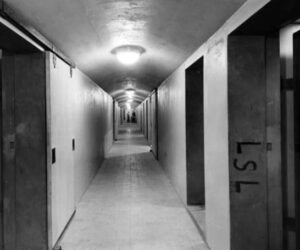
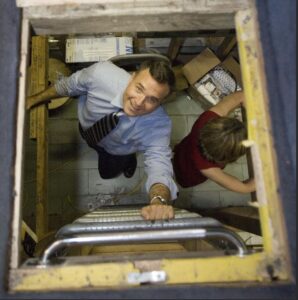 within the Oval Office, leads to the basement of the East Wing and on to the Treasury Building. Its construction, which was largely secret, created a large sinkhole in the White House rose garden. The tunnel was reportedly built to quickly get the president out of the office during an incursion, but it was also used at least once to sneak former president Richard Nixon into a foreign policy meeting. I’m sure there are other changes to the White House, that we are not privy to, and may never know, because there are always secrets in this kind of building.
within the Oval Office, leads to the basement of the East Wing and on to the Treasury Building. Its construction, which was largely secret, created a large sinkhole in the White House rose garden. The tunnel was reportedly built to quickly get the president out of the office during an incursion, but it was also used at least once to sneak former president Richard Nixon into a foreign policy meeting. I’m sure there are other changes to the White House, that we are not privy to, and may never know, because there are always secrets in this kind of building.
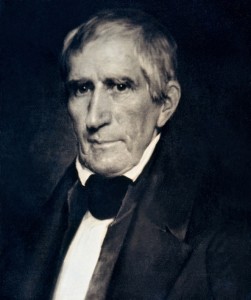
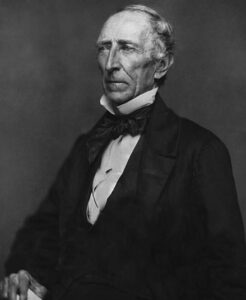 President William Harrison has the distinct record of having the shortest term in office in the history of the United States…exactly one month…from March 4, 1841 to April 4, 1841. His death and the immediate swearing in of his vice president, John Tyler on April 6, 1841, made Tyler the first vice president to immediately assume the role of president after a sitting president’s untimely exit and set the precedent for succession thereafter. It is thought that his illness was caused by the bad weather at his inauguration three weeks earlier, however, on Wednesday, March 24, 1841, Harrison took his daily morning walk to local markets, without a coat or hat. Despite being caught in a sudden rainstorm, he did not change his wet clothes upon return to the White House. He first fell ill with cold-like symptoms on Friday, March 26. His aids sent for his doctor, Thomas Miller. Harrison told the doctor he felt better after having taken medication for “fatigue and mental anxiety.” He might well have recovered from the cold, flu, or pneumonia that he was sick with at first, but to further complicate matters, Miller’s notes and records, found that the White House water supply was downstream of public sewage. With that newly revealed information, the conclusion now is that he likely died of septic shock due to “enteric fever” (typhoid or paratyphoid fever).
President William Harrison has the distinct record of having the shortest term in office in the history of the United States…exactly one month…from March 4, 1841 to April 4, 1841. His death and the immediate swearing in of his vice president, John Tyler on April 6, 1841, made Tyler the first vice president to immediately assume the role of president after a sitting president’s untimely exit and set the precedent for succession thereafter. It is thought that his illness was caused by the bad weather at his inauguration three weeks earlier, however, on Wednesday, March 24, 1841, Harrison took his daily morning walk to local markets, without a coat or hat. Despite being caught in a sudden rainstorm, he did not change his wet clothes upon return to the White House. He first fell ill with cold-like symptoms on Friday, March 26. His aids sent for his doctor, Thomas Miller. Harrison told the doctor he felt better after having taken medication for “fatigue and mental anxiety.” He might well have recovered from the cold, flu, or pneumonia that he was sick with at first, but to further complicate matters, Miller’s notes and records, found that the White House water supply was downstream of public sewage. With that newly revealed information, the conclusion now is that he likely died of septic shock due to “enteric fever” (typhoid or paratyphoid fever).
When Tyler took over, not everyone was happy about it. Tyler was a loyal supporter and advocate of states’ rights, including regarding slavery, and he adopted nationalistic policies as president only when they did not infringe on the powers of the states. His unexpected rise to the presidency posed a threat to the presidential ambitions of Henry Clay and other Whig politicians, and left Tyler estranged from both of the nation’s major political parties at the time. It was quite a predicament. When Tyler vetoed his fellow Whigs’ attempt to reestablish the National Bank, most of his cabinet resigned and he was thrown out of the Whig Party. What a 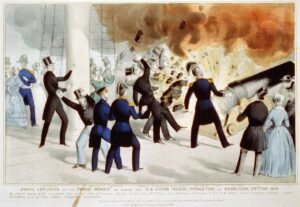 shock that must have been!! Tyler had already lost the support of the Democrats by denouncing Andrew Jackson’s policies as well, so Tyler became a president without a party. He began receiving death threats from both sides and quickly earned the enmity of Congress. His four years in office were chaotic. Nevertheless, he is credited with settling Canadian border disputes with Britain and beginning the annexation of Texas. Obviously, Tyler did not win a second term.
shock that must have been!! Tyler had already lost the support of the Democrats by denouncing Andrew Jackson’s policies as well, so Tyler became a president without a party. He began receiving death threats from both sides and quickly earned the enmity of Congress. His four years in office were chaotic. Nevertheless, he is credited with settling Canadian border disputes with Britain and beginning the annexation of Texas. Obviously, Tyler did not win a second term.
In 1844, during a cruise down the Potomac aboard the newly commissioned steam frigate USS Princeton, Tyler himself narrowly escaped death when the ships state-of-the-art cannon, called the Peacemaker, exploded as the crew fired a celebratory salute. The accident killed several people aboard, including two members of Tyler’s cabinet and his future wife’s father. Tyler was married twice. His first wife, Letitia Christian passed away in 1842, and he married Julia Gardiner in 1844. Between his two marriages, Tyler produced 15 children. Tyler’s unexpected ascendance to the presidency and the near-miss aboard the Princeton earned him the nickname of His Accidency.
After leaving the White House, Tyler retired to a Virginia plantation, originally named Walnut Grove (or “the Grove”), located on the James River in Charles City County. He renamed it Sherwood Forest, in a reference to the folk legend Robin Hood, to signify that he had been “outlawed” by the Whig Party. Tyler tried to broker a peace convention between the North and South on the eve of the Civil War, but he failed to reach an agreement with Abraham Lincoln on key issues. Denounced as a traitor by the North, Tyler fell in line with southern secessionists and, in 1861, was elected to the Confederate House of Representatives. Tyler suffered from poor health throughout his life. He was susceptible to colds and that got worse as he got older. On January 12, 1862, 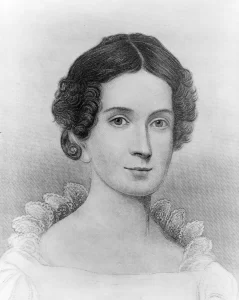
 after complaining of chills and dizziness, he vomited and collapsed. Despite treatment, his health failed to improve, and he made plans to return to Sherwood Forest by the 18th. As he lay in bed the night before, he began suffocating, and Julia summoned his doctor. Just after midnight, Tyler took a sip of brandy, and told his doctor, “Doctor, I am going”, to which the doctor replied, “I hope not, Sir.” Tyler then said, “Perhaps it is best.” He died shortly thereafter, most likely due to a stroke. He was 71. His death occurred on January 18, 1862. Tyler’s death was the only one in presidential history not to be officially recognized in Washington, because by then, his allegiance was to the Confederate States of America.
after complaining of chills and dizziness, he vomited and collapsed. Despite treatment, his health failed to improve, and he made plans to return to Sherwood Forest by the 18th. As he lay in bed the night before, he began suffocating, and Julia summoned his doctor. Just after midnight, Tyler took a sip of brandy, and told his doctor, “Doctor, I am going”, to which the doctor replied, “I hope not, Sir.” Tyler then said, “Perhaps it is best.” He died shortly thereafter, most likely due to a stroke. He was 71. His death occurred on January 18, 1862. Tyler’s death was the only one in presidential history not to be officially recognized in Washington, because by then, his allegiance was to the Confederate States of America.
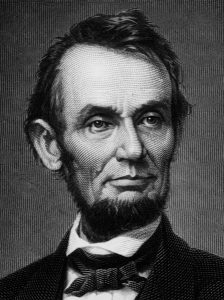 With Abraham Lincoln’s birthday just behind us…he was born on February 12, 1809. Most of us know that Lincoln had no formal education. We know that he gave amazing speeches and that he freed the slaves. We also know that he was assassinated, but there are a number of other Lincoln Facts that I didn’t know, and maybe you didn’t either. One sad fact is that Lincoln lost his mother at the tender age of 9 years old, when she drank poison milk. She wasn’t poisoned, but it turns out that many people died of a strange “milk sickness” that was caused by a cow eating a “poisonous to humans” plant called White Snakeroot. I’m sure it was a horrible time for Lincoln, but his father remarried, and the widow, Sarah Bush Johnston was a kind woman, who got along well with her step-son.
With Abraham Lincoln’s birthday just behind us…he was born on February 12, 1809. Most of us know that Lincoln had no formal education. We know that he gave amazing speeches and that he freed the slaves. We also know that he was assassinated, but there are a number of other Lincoln Facts that I didn’t know, and maybe you didn’t either. One sad fact is that Lincoln lost his mother at the tender age of 9 years old, when she drank poison milk. She wasn’t poisoned, but it turns out that many people died of a strange “milk sickness” that was caused by a cow eating a “poisonous to humans” plant called White Snakeroot. I’m sure it was a horrible time for Lincoln, but his father remarried, and the widow, Sarah Bush Johnston was a kind woman, who got along well with her step-son.
At the age of 21, Abraham Lincoln became a champion wrestler. I don’t know how he would have fared in WWE, but then that is a lot of drama and show too. Nevertheless, he wrestled in approximately 300 matches, and only lost once. It is thought that his long legs helped him lock his opponent down. Lincoln reportedly talked a little smack in the ring too. According to Carl Sandburg’s biography of Lincoln, “Honest Abe once challenged an entire crowd of onlookers after dispatching an opponent: ‘I’m the big buck of this lick. If any of you want to try it, come on and whet your 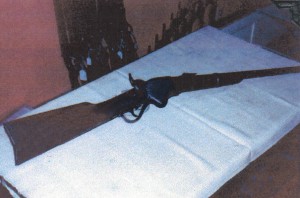 horns.’ There were no takers.” Lincoln’s grappling exploits earned him an “Outstanding American” honor in the National Wrestling Hall of Fame.
horns.’ There were no takers.” Lincoln’s grappling exploits earned him an “Outstanding American” honor in the National Wrestling Hall of Fame.
Lincoln is also the only president to have personally test-fired rifles outside the White House, including one by my ancestor, Christopher Spencer who was the inventor of the Spencer Repeating Rifle. When Spencer signed his new rifle up for adoption right after the Civil War broke out, it was not well received by the Department of War Ordnance, that felt soldiers would waste ammunition by firing too rapidly with repeating rifles. The unit was also more expensive than Springfield Model 1861 rifled musket in use at the time. Nevertheless, shortly after the famous Battle of Gettysburg, Spencer was able to gain an audience with President Abraham Lincoln, who invited him to a shooting match and demonstration of the weapon on the lawn of the White House. President Lincoln was so impressed with the weapon that he ordered General James Wolfe Ripley to adopt it for production. 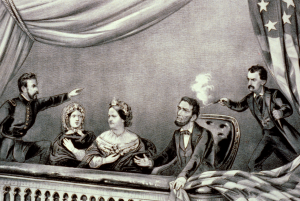 Unfortunately, Ripley disobeyed the order and continued to use the old single-shooters.
Unfortunately, Ripley disobeyed the order and continued to use the old single-shooters.
President Lincoln is also responsible for the safety of the presidents that followed him. Yes, there were failures, but without Lincoln’s decision to create the Secret Service on April 14, 1865, just hours before he was assassinated, many presidents in the future would not have had the quality of protection they did. The Secret Service did protect President Lincoln after his death, when grave robbers attempted to steal his body and hold it for a ransom of $200,000 and the release of one of their gang from prison. Their attempt was foiled by the Secret Service that President Lincoln had initiated.
 It was a long time coming. An actual house for the President of the United States was a long time coming. Prior to establishing the nation’s capital in Washington DC, the United States Congress and its predecessors had met in Philadelphia (Independence Hall and Congress Hall), New York City (Federal Hall), and a number of other locations (York, Pennsylvania; Lancaster, Pennsylvania; the Maryland State House in Annapolis, Maryland; and Nassau Hall in Princeton, New Jersey). Then, it was decided that our government needed a permanent home. Washington DC was selected.
It was a long time coming. An actual house for the President of the United States was a long time coming. Prior to establishing the nation’s capital in Washington DC, the United States Congress and its predecessors had met in Philadelphia (Independence Hall and Congress Hall), New York City (Federal Hall), and a number of other locations (York, Pennsylvania; Lancaster, Pennsylvania; the Maryland State House in Annapolis, Maryland; and Nassau Hall in Princeton, New Jersey). Then, it was decided that our government needed a permanent home. Washington DC was selected.
The first president who would have an actual government-owned home in Washington DC was President John Adams, and he would only live there for the last year of his only term in office. President John Adams, in the last year of his only term as president, moved into the newly constructed President’s House on November 1, 1800. The President’s House was the original name for what is known today as the White House. Adams and his wife had been living in temporarily at Tunnicliffe’s City Hotel near the half-finished Capitol building since June 1800, when the federal government 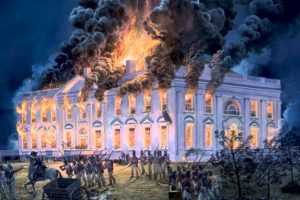 was moved from Philadelphia to the new capital city of Washington DC. When Adams first arrived in Washington, he wrote to his wife Abigail, who was still at their home in Quincy, Massachusetts, that he was pleased with the new site for the federal government and that he had explored the soon-to-be President’s House and liked it.
was moved from Philadelphia to the new capital city of Washington DC. When Adams first arrived in Washington, he wrote to his wife Abigail, who was still at their home in Quincy, Massachusetts, that he was pleased with the new site for the federal government and that he had explored the soon-to-be President’s House and liked it.
Although workmen had rushed to finish plastering and painting walls before Adams returned to DC from a visit to Quincy in late October, the construction was still unfinished when Adams rolled up in his carriage on November 1. However, the furniture from their Philadelphia home was in place and a portrait of George Washington was already hanging in one room. It was a decent start. The next day, Adams sent a note to Abigail, who would arrive in Washington later that month, saying that he hoped “none but honest and wise men [shall] ever rule under this roof.” I wish that 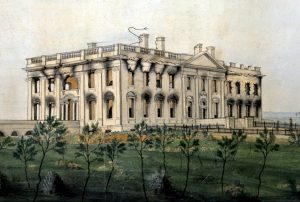 had always been the case, and of course the idea of good and bad presidents are often a matter of opinion.
had always been the case, and of course the idea of good and bad presidents are often a matter of opinion.
The President’s House though new had its issues. Adams was initially very pleased with the presidential mansion, but he and Abigail found it to be cold and damp during the winter. Abigail wrote to a friend saying that the building was tolerable only so long as fires were lit in every room. She also said that on a funny note, she also said that she had to hang their washing in an empty “audience room,” which is the current East Room. Now, that’s quite a thought. During the War of 1812, the White House was set on fire by the British, and had to be repaired.
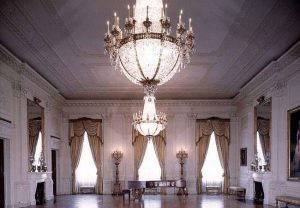 With the new school year just beginning, the reality is that the year’s end will arrive in incredibly short order. Football, basketball, and track will be over, and before we know it, the high school students are getting ready for prom again. Everyone wants their prom to be that wonderful dance that is unforgettable…one that they can carry the memories of forever. Proms are usually held in the school gym, or maybe at an events center, and on rare occasions, a hotel, but in 1975, in Washington DC, was held what could only be called the ultimate prom!! And don’t think your school could duplicate this particular prom, because they couldn’t. This particular prom was held at the White House!! It was the only prom ever to be held at the executive mansion, which makes it an odd event in White House social history.
With the new school year just beginning, the reality is that the year’s end will arrive in incredibly short order. Football, basketball, and track will be over, and before we know it, the high school students are getting ready for prom again. Everyone wants their prom to be that wonderful dance that is unforgettable…one that they can carry the memories of forever. Proms are usually held in the school gym, or maybe at an events center, and on rare occasions, a hotel, but in 1975, in Washington DC, was held what could only be called the ultimate prom!! And don’t think your school could duplicate this particular prom, because they couldn’t. This particular prom was held at the White House!! It was the only prom ever to be held at the executive mansion, which makes it an odd event in White House social history.
Our president at the time was Gerald Ford, and he had a 17 year old daughter named Susan. Like most daughters, Susan knew that her daddy wanted to make her happy. So, she asked him if her high school could hold their prom at the White House. It was the first and only prom ever to be held there…and not something that is likely to happen again. Susan went to school at the Holton-Arms school. The prom was held on March 31, 1975, and President and Mrs Ford were on their way from Belgium to Spain as part of a diplomatic tour of Europe. In their place was the president’s sister-in-law, Janet Ford, “a small figure in a white lace dress, casting  a tolerant but observant eye on the proceedings.”
a tolerant but observant eye on the proceedings.”
Over forty years later, the students who attended the regal prom still carry those wonderful memories of a very special prom that could never be equaled. They even got to take a sunset cruise on the presidential yacht. Many parties have been held at the White House, but none quite like this one. The White House was rockin’ that Saturday, with Susan Ford. her classmates and their dates, dancing the bump and the hustle in the East Room until 1:00am. Susan had been a student at the Holton-Arms School, an academy for girls in Bethesda, Maryland, since her freshman year. “The members of the class of 1975 paid the cost of the prom…$1,300, after raising funds at bake sales and school fairs. Tablecloths were made out of floral pink and yellow sheets. The menu included Swedish meatballs and quiche, as well as a nonalcoholic punch made of tea, lemonade, soda, grape juice, and sugar. Susan and her classmates assembled the centerpieces, candles in a setting of daisies, tulips, lilies, sweet peas, and ming fern.”
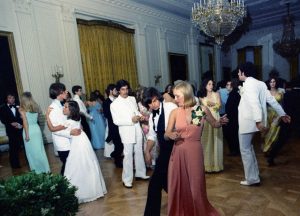 “The girls wore long dresses, light makeup, casual hairdos, and, in many cases, orchid corsages,” the Associated Press reported. “Many of their escorts, in black or white tuxedos, wore boutonnieres and below-the-collar length hair.” “Susan, at that age, was strikingly beautiful,” says Sally Alexander, a retired English teacher at Holton-Arms, who was one of six chaperones. “And it’s a great deal of fun to watch a bunch of beautiful young girls with handsome young men, all dressed up. They were clearly excited about being where they were, but they were not uncomfortably awed. It was a beautiful affair.” And of course, the media was there to document the entire historic prom. So, if you want your prom to be this cool, you had better start planning now…or maybe several years ago.
“The girls wore long dresses, light makeup, casual hairdos, and, in many cases, orchid corsages,” the Associated Press reported. “Many of their escorts, in black or white tuxedos, wore boutonnieres and below-the-collar length hair.” “Susan, at that age, was strikingly beautiful,” says Sally Alexander, a retired English teacher at Holton-Arms, who was one of six chaperones. “And it’s a great deal of fun to watch a bunch of beautiful young girls with handsome young men, all dressed up. They were clearly excited about being where they were, but they were not uncomfortably awed. It was a beautiful affair.” And of course, the media was there to document the entire historic prom. So, if you want your prom to be this cool, you had better start planning now…or maybe several years ago.
 Everyone knows that President Lincoln was assassinated on Good Friday, April 14, 1865, while attending the play Our American Cousin at Ford’s Theatre in Washington, DC, as the Civil War was drawing to a close, but what you may not know is that this was not the first attempt on Abraham Lincoln’s life. The first attempt came one August night in 1864, just under a year before the successful attempt by John Wilkes Booth. It is unknown who the would-be assassin was in that earlier attempt, just that they very nearly succeeded.
Everyone knows that President Lincoln was assassinated on Good Friday, April 14, 1865, while attending the play Our American Cousin at Ford’s Theatre in Washington, DC, as the Civil War was drawing to a close, but what you may not know is that this was not the first attempt on Abraham Lincoln’s life. The first attempt came one August night in 1864, just under a year before the successful attempt by John Wilkes Booth. It is unknown who the would-be assassin was in that earlier attempt, just that they very nearly succeeded.
President Lincoln and his family often stayed at the Soldiers’ Home during the summer months due to the unbearable heat at the White House. President Lincoln often made the 4 mile trip from the White House to the Soldiers’ Home alone, and often late at night, an unheard of situation these days, with the secret service officers always shadowing the presidents, vice-presidents, and their families. As Lincoln was riding along that night, a shot rang out. Private John W Nichols, who was stationed at the Soldiers’ Home, rushed to the aid of the president, whom he found well, but missing his hat. President Lincoln told the private that the horse jerked upon hearing the gunshot, and his hat went flying. The private went to retrieve the hat for the president, and went he 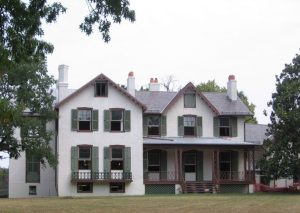 examined it, he found that it now had a bullet hole in it. It was an extremely close call, but President Lincoln requested that the matter be kept quiet, and Private Nichols didn’t tell the story until 1867. His tall hat had saved his life by causing the would be assassin to aim too high to hit his head.
examined it, he found that it now had a bullet hole in it. It was an extremely close call, but President Lincoln requested that the matter be kept quiet, and Private Nichols didn’t tell the story until 1867. His tall hat had saved his life by causing the would be assassin to aim too high to hit his head.
For America, this missed shot changed history. Had Lincoln been killed on that August night…even just that much earlier would have had devastating consequences for America. Hannibal Hamlin would have become a lame duck president. Hamlin was already off the Union ticket for vice president, having been replaced by Andrew Johnson. Hamlin would have faced strong opposition, because at the time, the Radical Democracy Party…an offshoot of the Republicans…and their nominee, John Fremont, had not yet dropped from the race. The Radical Democracy Party were even more strongly opposed to slavery than Lincoln, which is what led to their formation. Had the assassin aimed a bit lower in 1864, the election in November would likely have pitted Hamlin against Fremont and McClellan, the Democratic nominee, with Johnson perhaps running on the Union ticket.
Presidential elections always rest on who can win in an election, and in this case the winner would have turned 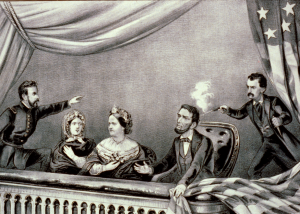 1864 America into a mess. Had the earlier would-be assassin’s shot been just a little lower, Lincoln, would have been succeeded by Hannibal Hamlin which may have given the upcoming election to Lincoln’s overly cautious former commander, General George McClellan. How either Hamlin, had he actually won re-election, or McClellan would have carried on the last year of the war, much less dealt with southern reconstruction, is a source for debate. Lincoln’s death, if combined with a lame-duck Hamlin and a conciliatory McClellan, might have encouraged the South to hold on just a while longer and resulted in an armistice rather than a victory, dramatically changing the history of America. I don’t think that anyone but Lincoln could have freed the slaves at that time.
1864 America into a mess. Had the earlier would-be assassin’s shot been just a little lower, Lincoln, would have been succeeded by Hannibal Hamlin which may have given the upcoming election to Lincoln’s overly cautious former commander, General George McClellan. How either Hamlin, had he actually won re-election, or McClellan would have carried on the last year of the war, much less dealt with southern reconstruction, is a source for debate. Lincoln’s death, if combined with a lame-duck Hamlin and a conciliatory McClellan, might have encouraged the South to hold on just a while longer and resulted in an armistice rather than a victory, dramatically changing the history of America. I don’t think that anyone but Lincoln could have freed the slaves at that time.

 As a thankful nation took time to honor it’s fallen peace officers, my brother-in-law, Chris Hadlock, who was Wyoming’s Peace Officer of the Year, was among those invited to attend the services to honor fallen comrades across the nation. A solemn occasion, it began on Saturday with a candlelight vigil, to remember those officers who lost their lives in the line of duty this year. It was an awe inspiring ceremony with an awe inspiring crowd of police officers, their families, and of course, the families of the fallen. This ceremony is, after all, for the loved ones of the fallen heroes…the families, who also made the ultimate sacrifice. No one can understand what a sacrifice that was, until they have gone through it themselves.
As a thankful nation took time to honor it’s fallen peace officers, my brother-in-law, Chris Hadlock, who was Wyoming’s Peace Officer of the Year, was among those invited to attend the services to honor fallen comrades across the nation. A solemn occasion, it began on Saturday with a candlelight vigil, to remember those officers who lost their lives in the line of duty this year. It was an awe inspiring ceremony with an awe inspiring crowd of police officers, their families, and of course, the families of the fallen. This ceremony is, after all, for the loved ones of the fallen heroes…the families, who also made the ultimate sacrifice. No one can understand what a sacrifice that was, until they have gone through it themselves.
Yesterday was the 36th Annual National Peace Officers Memorial Service. President Trump and Vice President Pence both spoke at the service, and when they were finished speaking, there was an atmosphere of hope among the officers and their families. President Trump has taken a strong stance concerning our law enforcement officers, saying “The attacks on our police are a stain on the very fabric of our society, and you are entitled to leadership at the highest level that will draw a bright line in the sand — not a red line in the sand that isn’t gone over — but a bright line in the sand. And we will protect you. That I can tell you. And we will say, “Enough is enough.” The attacks on our police must end, and they must end right now.” He also said, 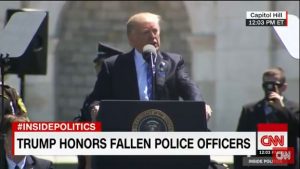
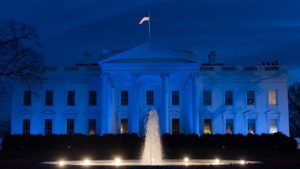 “We must also end the reckless words of incitement that give rise to danger and give rise to violence. It is time to work with our cops, not against them, but to support them in making our streets safe; not to obstruct them — which we’re doing, we obstruct them. It is time for all Americans, from all parties and beliefs, to join together in a simple goal to ensure that every child in America has the right to grow up in safety, security and peace. True social justice means a future where every child, in every neighborhood, can play outside without fear, can walk home safely from school, and can live out the beautiful dreams that fill their heart.”
“We must also end the reckless words of incitement that give rise to danger and give rise to violence. It is time to work with our cops, not against them, but to support them in making our streets safe; not to obstruct them — which we’re doing, we obstruct them. It is time for all Americans, from all parties and beliefs, to join together in a simple goal to ensure that every child in America has the right to grow up in safety, security and peace. True social justice means a future where every child, in every neighborhood, can play outside without fear, can walk home safely from school, and can live out the beautiful dreams that fill their heart.”
It was a speech filled with hope and those who were blessed enough to be there felt awe inspired….and humbled at the same time. They were standing in the midst of heroes, both living and remembered. They were all in this fight together…a fight to make our nation safer, and to make it a place where our children can play outside without fear of kidnap or death. As President Trump has stated, “One of the fundamental rights of every American is to live in a safe community. A Trump Administration will empower our law enforcement officers to do their jobs and keep our streets free of crime and violence. The Trump Administration will be a law and order administration. President Trump will honor our men and women in uniform and will support their mission of protecting the public. The dangerous anti-police atmosphere in America is wrong. The Trump Administration will end it.” In addition to that amazing speech, President Trump had the White House lit up blue in honor of the police officers of this nation.
The trip that my brother-in-law was honored with for being Wyoming’s Peace Officer of the Year, concluded 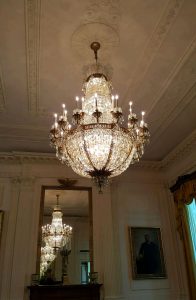

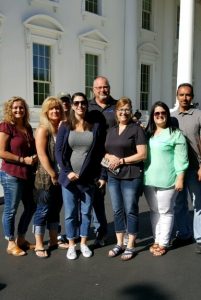 today with a tour of the White House. This is a tour that not many people get to take…especially these days. The tour and the pictures they took will be a treasure for them forever. My sister, Allyn Hadlock said that she “felt so honored and privileged to be there! It was a wonderful glimpse into the past and future” Our family is very excited that they got to take this trip, and very proud of Lieutenant Chris Hadlock, Wyoming’s Peace Officer of the Year. You’re a credit to Wyoming!!
today with a tour of the White House. This is a tour that not many people get to take…especially these days. The tour and the pictures they took will be a treasure for them forever. My sister, Allyn Hadlock said that she “felt so honored and privileged to be there! It was a wonderful glimpse into the past and future” Our family is very excited that they got to take this trip, and very proud of Lieutenant Chris Hadlock, Wyoming’s Peace Officer of the Year. You’re a credit to Wyoming!!

